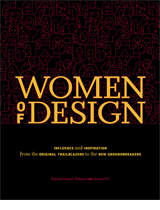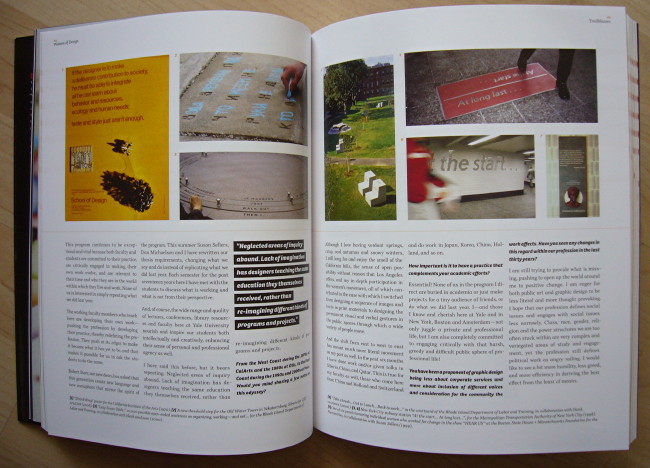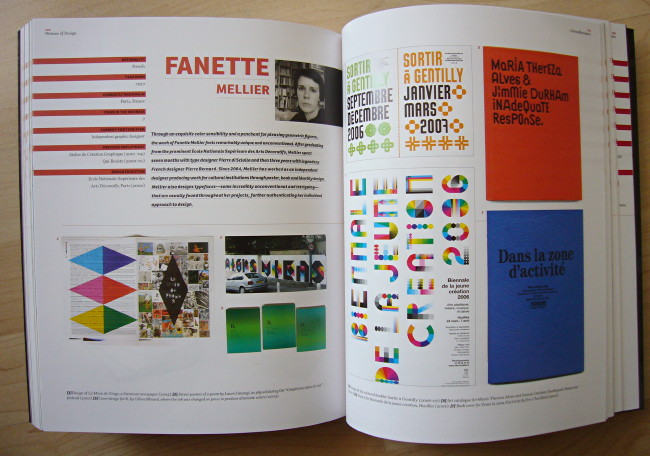(UPDATED) Why aren’t there more wymmynz in graphic design?
The question is asinine. There are “enough” women in graphic design. That is, in a free society, it is up to women to choose to pursue design. The same applies to men. There are as many designers as wish to be.
Why aren’t there more wymmynz at high levels of graphic design – heading entire firms or academic departments? For the same reason there aren’t many female CEOs or law partners or engineers: Women have biological clocks and tend to drop out of the rat race to have kids at the same periods in their lives. Few women are neurologically predisposed to perform the same task for unremitting years on end, or to focus on abstractions or things for the same period of time. That isn’t sexism, it’s neuroscience. Contain your outrage and get your hands on the books by Pinker and Gurian.
Of course, the peer-reviewed research these authors report has to be wrong – indeed, it has to be The Bell Curve redux – because it conflicts with your insistence, based on nothing you can put your finger on, that every job must be 50% female. But you still want women’s jobs to stay that way. In fact, men’s jobs are viewed as the desirable ones and it is only those jobs where a 50% female quota is ostensibly required. (Nobody asks for an even gender split; what they ask for is 50% women.)
The definition is circular: If mostly men do a job, except of course for something like coal miner or roofer, then it must be a good job and women deserve half the positions.
But I doubt you want actual gender equality in the workplace. You do not want mostly-female jobs to become 50% male. You do not want half of nurses to be men, in part because most of them would be gay, as male nurses are now. You do not want more male schoolteachers, and you would actually go to court to prevent any male-teachers group from demanding a 50% quota on, say, kindergarten and primary-school teachers, particularly in all-girls private schools.
The entire discourse around sex distribution in employment has nothing to do with individual factors like interests and aptitude, nothing to do with actual scientific findings, and everything to do with unexamined biases. Would it be OK for male-dominated jobs to stay that way if most of the men were gay? If half the engineers and CEOs and law partners in the world were gay males, would there really be a need for 50% female hiring at that point?
Let’s try this another way. Would you like to pass a law requiring that no fewer than half of employable people with disabilities be gainfully employed in the free labour market, with accommodations paid for by the employer? No? Well, why not? Disabled people have higher unemployment than nondisabled women.
Do you want equality of outcome or do you want equality of opportunity? Have you even considered that question?
Then how come you even bother to raise the question of why “so few” women are in graphic design?
Do you want equality of opportunity or are you advocating some kind of revenge fantasy against sexist discrimination in the design industry – which, by virtue of its nonexistence, you have never been able to prove?
Have you suffered sexist discrimination in the workplace? Perhaps you have. It’s wrong and quite likely it is illegal where you live. But I’ve suffered it, too; in fact, I won a settlement for a breach of my human rights. (That means real, Steyn- or Levant-compliant human rights. Like the right not to get fired for reasons unrelated to job performance.) So I’m not going to argue that workplace discrimination is nonexistent. Except of course it’s practised more typically against disabled people (the plurality of employment-related complaints in Ontario).
Employment discrimination isn’t the reason women fail to dominate the highest ends of the graphic-design field. Neuroanatomy, hormones, developmental stages, and direct individual choice are the reasons. Another significant factor is the truth that designers are often self-employed, and not even a Muslim woman in hijab is going to discriminate against herself.
 Nonetheless, women of design now have their own book, unconfusingly entitled Women of Design, by Bryony Gomez-Palacio and Armin Vit (in that order; q.v.). Its purpose is clear even if the authors are evasive about it. Surely the apparent global conspiracy against women of design can be undermined by more awareness. Surely women are being held back in design because people, that is, men, don’t know how good they are. A full-colour book is a plausible method of redress.
Nonetheless, women of design now have their own book, unconfusingly entitled Women of Design, by Bryony Gomez-Palacio and Armin Vit (in that order; q.v.). Its purpose is clear even if the authors are evasive about it. Surely the apparent global conspiracy against women of design can be undermined by more awareness. Surely women are being held back in design because people, that is, men, don’t know how good they are. A full-colour book is a plausible method of redress.
Whatever could be wrong with Women of Design? Beyond its central premise?
A lot of them are already famous
Scanning through the table of contents, unhelpfully typeset full-bleed and double-truck in pale orange, darker orange, and darker-still orange on white, I recognized 30 out of 71 names right off the bat. A pretty good percentage, I’d say, though clearly that is self-delusion. My ignorance of 41 of these 71 women is proof of the general problem. Or is it?
Right there at the top of p. 2 is the statement “Originally, we had envisioned a book that would include the ‘top 30’ women of design.” They’re the same 30 everybody already knows and they don’t need any more press.
You can’t sell a book like this – to a publisher or to the self-limiting reading public – without including famous names. Hitherto Unheralded Women of Design wouldn’t get published in the first place. Commercially nonviable designers, even if female, don’t get any press.
So those 30 well-known designeuses are more like the sequels, romcoms, and action pictures that keep Hollywood afloat and subsidize the high-class historical dramas and auteur-driven films that get run up the flagpole at Oscar time. Here it’s a design milieu and the romcoms are those 30 designers I promise you’ll already have heard of.
They’re mostly American
The coauthors are Mexican immigrants to the United States. They moved from New York to Austin, where there are tons of other Mexicans. I know they’re embracing the American Dream, but could we not have expected a “global perspective” from immigrant writers? Is male domination of graphic design, to the extent it exists, as much of a sin as the American domination that this book exhibits?
I counted them up: 50 subjects are Americans or hyphenated Americans (Bulgarian-, Greek, Italian-German-, Italian-, Mexican-). Irksome self-satisfied elitist Chee Pearlman is an American no matter what she calls herself – here, “global citizen.” (How is Cuba in summertime, Chee?) Endearingly, place of residence of each of these Americans adds “United States,” as though we didn’t know where New York had been hiding all along.
Austria, Belgium, Canada, Germany, France, Japan, Korea, Mexico, the Netherlands, and the U.K. are the other countries represented (never more than three each). I am reasonably sure one could publish a book entitled Women of Toronto, Montreal, and Vancouver Design all by itself (ditto Melbourne, Sydney, and Brisbane or just London).
Women of Design runs the gamut of chromosomes from X to X and the gamut of nationalities from U to S.
They aren’t hurtin’
Even the unsung or little-known women of design featured here have thriving practices – or something they would personally consider an equivalent success, as in having enough academic work or enough writing work. Again: Do even these women need more press? Don’t they have their own Web sites?
It’s all about big, showy layouts that reduce well to thumbnail size

Recapitulating a standard structural deficiency of graphic-design criticism, examples of these designeuses’ work selected for inclusion are those that read well in thumbnail form – full-page layouts and spreads, packaging design, interiors, posters.

When the subject is a writer like Emily King, off-kilter photographs of entire published books, including spine, indicate the poverty of illustrative vocabulary available to the authors.
Two designers made the same editorial statement
“Ornament” got “decriminalised” once on p. 158, then “decriminalized” all over again on 208.
Did subjects truly “design” everything?
In several cases, projects illustrated are claimed to have been creative-directed by someone else (viz Paula Scher creative-directing Julia Hoffmann). So who’s the designer? Or, if you need it explained in Poynorese, who’s the designer as author?
Cover-to-cover imperfections
I like the general “graphic design” of the book, as distinct from its “typography.” Still, the book betrays the authors’ blog heritage by failing to understand that we do not actually separate paragraphs with a blank line and no indent, as though this were a default TypePad installation or a Word 97 document.
Through this design “decision” alone, Women of Design ends up looking like an O’Reilly book in drag. Paragraph design of that sort encourages readers to skip to the next graf if the current one doesn’t seize you with interest in the first two lines.
There really isn’t a baseline grid to speak of in body copy. And of course there are copy errors.
- There’s a giant errant comma on p. 95 and its antecedent.
- That is not an eth on p. 133 (∂ ≠ ð).
- The name McCoy, when rendered in all caps, is McCOY, not MCCOY, and How and Step are magazine titles (HOW and STEP are not; cf. “KISS”).
- One emphasizes “a lot” with italics, not capitals, as this is not IRC we’re dealing with here.
By the sound of her voice on podcasts, Gomez-Palacio – somehow I think a diacritic got lost in there – is apparently a Mexican Spanish/U.S. English bilingual; Armin Vit speaks with an accent. Line editing should have been tightened to excise first-language interference from Spanish.
- Outcast isn’t really a verb (one casts out).
- Ruth Ansel’s entry includes a sentence beginning with “Since 1992, Ansel runs her own studio,” which I’m sure sounded better in the original French (Depuis 1992, Mme Ansel gère son propre studio).
- Nothing can be “reciprocally heartbreaking.” (“And, in retrospect, heartbreaking”?)
- Do the authors even know what aleatory means (“random”)? More importantly, do they know how rare the word is in English? (It isn’t rare in French. How about Spanish?) See also “dictum,” used just as incongruously.
- The province between Ontario and New Brunswick is Quebec, not “Québec.” (Or did they mean the capital, Quebec City [also not “Québec”]?)
- Marian Bantjes does not live on “a small, 3,500-people island.” (Where she earns lots of “moneys”?)
- Photo credits go at the end of a book, not in a footnote, and especially not when the footnote pays obeisance to a multinational corporation.
I have my own additional bugbears, like the phrase “divide my time.” You can divide cookie dough or an apartment or Serbia, or cookie dough in a Serbian apartment, but “time” you cannot “divide.”
Is Laurie Haycock Makela really an “ex-patriot” just because she lives in Sweden now?
Did you know she does? I didn’t. Anyway, the word is invariantly expatriate (also expat); neither is hyphenated. She and Ronald Jones now run O-B-O-K in Sweden.
At the end of my days in the U.S., I began to see “graphic” design as irrelevant. I no longer cared about new typefaces, youth culture, and the 10% who have access to technology. As a social-welfare state, Sweden rejected postmodernism and the aggressive hubris of Americans. I have learned the grace of failure and humility in Sweden, for which I am grateful.
She then goes on to list three men in her life who have influenced her. Take that.
Some subjects aren’t even interviewed
A few subjects just get an intro and some pictures, not an interview. One example is Catherine Zask (p. 75), who apparently had the temerity to be unable to speak English or Spanish. (She filled out a questionnaire, she later told me; there wasn’t an interview.)
Several subjects, including two with no interview, are not even photographed. One subject gets a twee little illustration (an Illustrator hack job) rather than a photo. Tamye Riggs is indulged with the stupidest photograph I’ve seen all year.
Interviews aren’t really interviews
They’re prepared statements. Sort of like what you get from a pro-family Republican congressman as he publicly admits to an extramarital affair with a man.
How does the book address Babs Kruger?
- We have to admit, though, you’ve really killed Futura Bold Oblique for all of us. We can’t use it without someone saying “That looks like Barbara Kruger”—
- My goodness. You know, I never thought anyone would know my name. It’s just funny the way historical circumstances, social relations, and historical reckonings are constructed… It’s so weird. But anyways, I interrupted the question…
I believe she really talks like that, OK? With academic vocabulary and ellipses. But I also know for a fact this was the only interview in the book, the only one, conducted via phone or in person. All the rest of them were done via E-mail, as Vit confirmed.
I think E-mail interviews should be reserved for the most trifling cases, like that time I sent along some questions to that guy from Sloan for a little blog post about a theme song for a dreadful TV show. E-interviews are to be avoided in every other instance. Should you be unclear what “avoid” means, let me say it another way: Don’t ever use them for anything serious.
Why? Interviewer and subject both lose credibility. People rehearse their answers. Even the questions get rehearsed. Honest people sound evasive, or they just fluff themselves up. Everybody else gets all the time they need to polish their lies to a gleaming shine.
People try to sound better than they really are. How they end up sounding is stilted and unnatural. Open to any page from 9 to 239 save for 12, 13, or 14. Moira Cullen, on pp. 226 and 228, is by far the worst example, so bravo there, Moira.
I have on several occasions listed sources as having refused to comment because the only way they wanted to do it was by E-mail (top-posted E-mail to boot). You are refusing to comment if you insist I file my questions in advance, as in some kind of Third World republic whose president you recently assassinated. You’ll answer my question when you hear me ask it and that’s that. (I am happy to work through an interpreter or the relay service, but I generate the question in real time and you answer in real time.)
Gomez-Palacio and Vit are not journalists and they’re barely writers. I don’t know what “design writers” in general are. They’re undefinable creatures, more akin to ticks clinging to a dinosaur’s pelt. I guess they’re designers who are not illiterate. I have covered this species before. Its members have no knowledge of journalistic ethics. Hence I shouldn’t be surprised that Women of Design reads like 69 press releases with really punchy pictures attached.
Concentrating on women ignores partners
I don’t see many lesbians in this book, if any. Wymmynz of design who are actually married, or have male heterosexualist partner units, are featured with those partners excised from the story, or just mentioned in passing. This latter-day Kremlinology is ostensibly the reason women don’t get their due in graphic design: They’re written out of history. (It’s a lie. This book proves the lie. But that’s the received wisdom.)
An even more serious failing arises with business partnerships. When a woman and a man, or two women and a man, or a man and two women, or some other combination go into business and the business thrives, the message this book sends is that only the women made it happen. This too recapitulates the historical invisibility of wymmynz in design, only in reverse.
Recounting the tale of a design business in this way is at best incomplete and at worst dishonest.
The book dodges a large bullet in that it features both partners in the handful of two-woman shops it covers.
Capper
Did you know Paula Scher’s husband is Seymour Chwast?
Update
Véronique Vienne lays waste to Women of Design in Eye. She should know; she was in it.
The authors of Women of Design have done their best to avoid any semblance of radicalism. They have adopted an overtly friendly, late-night-TV interview style, fudged generational gaps by defining the women in broad chronological terms (trailblazers, pathfinders, groundbreakers), and peppered the text with so many teasers, pullquotes and highlighted statements that it looks like a camouflage pattern designed to conceal rather than reveal the singularity of each artist.
Flipping through the book is like speed-dating. After a while all the entries look the same, and you cannot remember whether it is Chee, Emily, Joyce or Julie that is the celebrated i-D [sic] magazine editor.
A copy of this book resides at the Beaches branch of the library and hasn’t moved in months, even after I did some visual merchandising and placed it on a conspicuous stand.